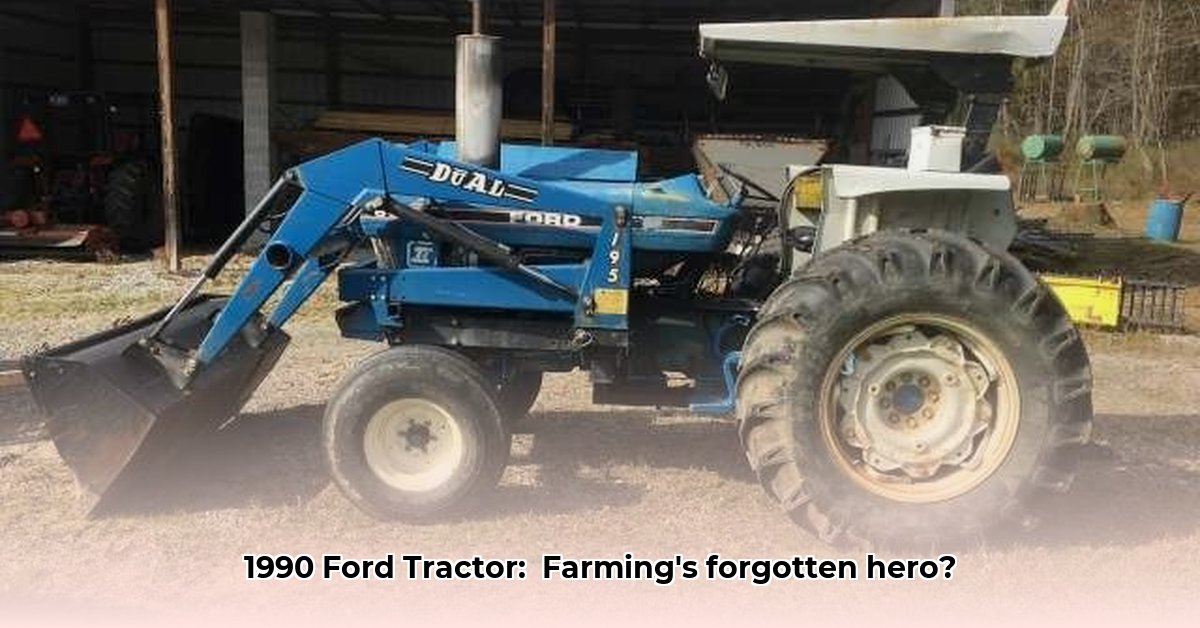
A Legacy of Sustainable Farming?
The 1990 Ford tractor, a common sight in fields across America, represents a key moment in agricultural technology and its evolving relationship with environmental stewardship. While seemingly outdated, its design and operation offer surprising insights into sustainable farming practices, prompting the question: Can a machine from three decades ago contribute to a modern, eco-conscious approach to agriculture? For more on tractor hitches, see this helpful resource.
Fuel Efficiency: A Step in the Right Direction
Compared to its predecessors, the 1990 Ford tractor boasted improved fuel efficiency. Engine refinements and transmission upgrades allowed farmers to cultivate larger areas with less fuel consumption. This translated to lower operating costs and, critically, a reduced carbon footprint. But was this incremental improvement sufficient to earn the "sustainable" label in the context of modern standards? The answer is nuanced.
Durability and the "Repair vs. Replace" Dilemma
The 1990 Ford's longevity and ease of repair are crucial for evaluating its sustainability. Unlike the often disposable nature of modern machinery, these tractors were designed for long-term use and repair, a stark contrast to today's "if it breaks, replace it" mentality. The relative availability and cost of replacement parts is a critical factor – were repairs affordable and readily achievable for these vehicles? This contrasts greatly with today's sophisticated, often complex, modern equivalents. This direct approach is a key testament to earlier design philosophies and highlights the need for a more thoughtful approach to equipment lifecycles within modern sustainable farming.
Comparing Generations: 1990 vs. Modern Tractors
Modern tractors have undoubtedly leapfrogged the 1990 Ford in terms of horsepower, technological sophistication, and fuel efficiency measures. However, this progress comes at a potential cost. Experts suggest that we may have compromised the longevity and repairability of modern farm equipment in pursuit of these advancements. A comprehensive life-cycle assessment—comparing fuel efficiency over the entire lifespan of both a 1990 Ford and a modern counterpart, factoring in repair costs and replacement parts—is needed to reach a definitive conclusion. Do the immediate fuel savings of new tractors outweigh the environmental impacts of their shorter lifespans and disposal considerations?
Manufacturing and Materials: A Holistic View
The materials used in constructing both 1990 and modern tractors significantly impact their sustainability. The manufacturing processes themselves, from raw material sourcing to final disposal, require careful consideration. A holistic life-cycle assessment offers the clearest picture of a tractor's environmental footprint, including energy consumption during manufacturing and the environmental cost associated with material sourcing and end-of-life disposal. Ongoing research in this area is essential for refining manufacturing processes and material selection to yield more environmentally friendly equipment.
Beyond the Machine: The Ecosystem of Sustainable Farming
It's crucial to remember a tractor's importance within the wider context of sustainable farming. This broader picture includes soil health, crop rotation, responsible water management, and integrated pest management. The tractor is a tool, its impact dependent upon the practices it serves. A highly efficient tractor employed within unsustainable practices will negate its contributions to a more environmentally friendly approach to agriculture.
Building a Sustainable Future: Learning from the Past
The 1990 Ford tractor, and its peers, offer valuable lessons for building a sustainable agricultural future. It's vital to focus, not just on efficiency, but on durability, repairability, and the use of sustainable materials in agricultural equipment design and production. This necessitates a fundamental shift in thinking, possibly moving towards simpler, less technologically complex designs that emphasize repairability over planned obsolescence. Learning from the strengths and limitations of older machinery like the 1990 Ford offers insights to guide the creation of more environmentally responsible agricultural machinery.
Key Specifications: A 1990 Ford Tractor (Illustrative Example)
| Feature | Specification (Examples) | Notes |
|---|---|---|
| Engine Type | Diesel | Various engine sizes available |
| Horsepower | 70-100 HP (approx.) | Varied based on specific model |
| Transmission Type | Manual/Powershift | Specific transmission type varied by model |
| Fuel Efficiency | Varies greatly depending on model, operation, and conditions | Requires further research for specifics |
| Weight | Varies greatly depending on model and configurations | Requires further research for specifics |
(Note: Specific specifications varied substantially depending on the exact model. This table provides approximate values for illustration.)
Improving Ford Tractor Fuel Efficiency for Sustainable Farming
Key Takeaways:
- Fuel efficiency is paramount to both economic and environmental sustainability in farming.
- Engine type, size and transmission design significantly affect fuel consumption.
- Regular maintenance, correct tire pressure, and operational optimization contribute to fuel savings.
Practical Steps to Boost Fuel Efficiency
- Regular Maintenance: Consistent oil changes, air filter replacements, and fuel filter cleaning are essential for optimal engine performance and fuel efficiency.
- Tire Pressure: Maintaining correct tire pressure reduces rolling resistance, improving fuel economy.
- Efficient Operations: Plan fieldwork carefully, minimize idling, and select appropriate implements for every task to reduce fuel consumption.
- Advanced Engine Upgrades (Optional): Consider upgrading to more fuel-efficient injection systems if feasible.
- Alternative Fuels (Optional): Explore biodiesel blends, ensuring compatibility with your tractor's engine.
Comparing Transmission Types
Older manual transmissions, common in 1990 Ford tractors, are less efficient than modern, continuously variable transmissions (CVTs). CVTs maintain optimal engine RPM regardless of tractor speed, resulting in superior fuel economy. Choosing the right transmission can improve fuel efficiency considerably.
Long-Term Sustainability: A Holistic Approach
While optimizing a 1990 Ford is beneficial, considering long-term sustainability is crucial. Exploring government subsidies and analyzing the long-term cost savings of a newer, more fuel-efficient tractor is vital for maintaining financial stability while also safeguarding the environment. The initial investment can translate to substantial long-term cost savings and enhance environmental responsibility. A balanced approach that weighs the short-term cost with long-term benefits is crucial.